Review: Logic Pro X
In the four years before Apple made the surprise announcement that it would release the […]
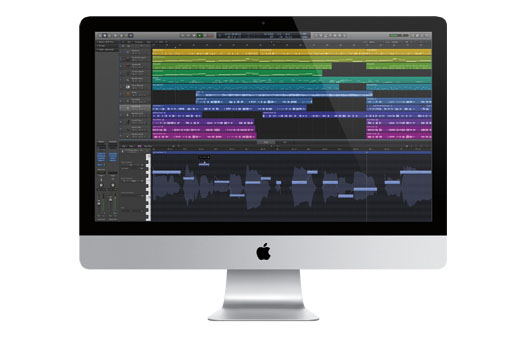
In the four years before Apple made the surprise announcement that it would release the next generation of its flagship audio program, Logic Pro X, there was much internet speculation (and even a little bit of fear) that Apple had planned to completely reconfigure Logic to act more like a beginner’s music production software—such as GarageBand—than a professional audio program. While Logic X does come with some new features aimed rather squarely at home songwriters and GarageBand graduates, this ultimately does not prove to be the case. With its latest update, Apple has made this version of Logic the smartest one yet, retooling the GUI, adding iPad remote control, and making for a more fluid workspace overall.
How It Looks
The refined graphic interface is the first immediately noticeable difference between Logic Pro X and its predecessor, as the updated program now sports a darker hue along with bolder icons and lettering—details which not only make it more pleasant to look at, but also somewhat easier to visually navigate. Furthermore, a few of the program’s key components have moved to new, largely more intuitive locations; the Transport now appears at the top-center of the screen, while the Library has moved from the right side to the left side of the screen. There are many other smaller changes that help make a more fluid workflow, such as volume and pan controls being accessible in the arrange window (in a similar fashion to GarageBand) and channel strips arranging their components to automatically reflect each channel’s signal flow. A new overlay has also been added to these channel components which makes bypassing a plug-in or opening its controls possible with a simple single click.
A session in Logic X
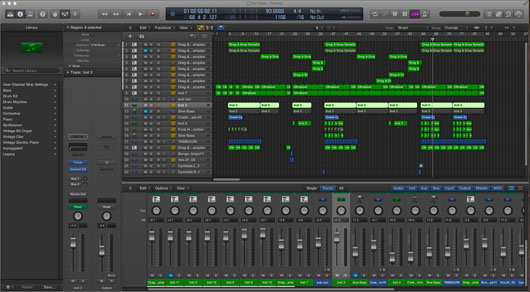
In truth, Logic X’s visual arrangement is largely identical to Logic 9 except for the modernized color scheme and the handful of other seemingly small changes already mentioned. Still, when taken together, they do make using the program less cumbersome, especially for any users who are more familiar with programs that accomplish many of the same tasks with less collapsible windows. Also useful to new Logic users is the Quick Help window, which serves as a concise and immediate reference for just about every feature the program has. Like Quick Help, a lot of these “new” visual features are a bit overdue in Logic, as they’ve existed in other programs for some time now, but they are nonetheless welcome improvements which make for a more productive user experience.
How It Works
In a similar fashion to the small-but-effective visual enhancements of Logic Pro X, the program offers some slight-but-useful updates to workflow, including the ability to create Track Stacks (multiple tracks grouped into a single, foldable track) and Summing Stacks, which sums all of a Track Stacks’ audio through one main channel. Another useful new feature is the Smart Control panels, which act similarly to the Macro Controls in Ableton, allowing users to adjust multiple parameters in a processing chain using one knob or button. For all of Logic’s included presets, existing Smart Controls arrive ready-to-use, but each one can be fully customized by the user or built from the bottom up using a number of templates.
Top: Drum machine controls on remote iPad app; Bottom: Mixer panel on iPad app
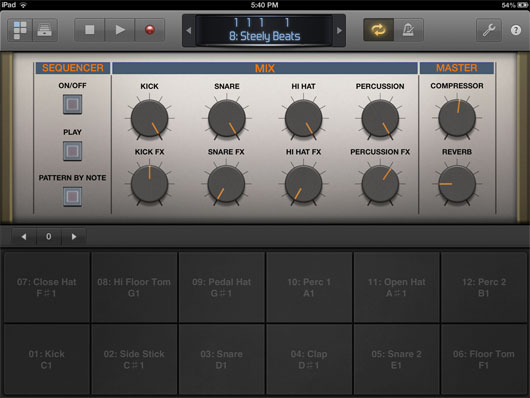
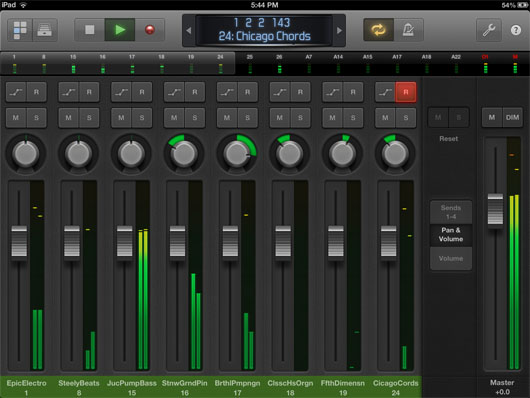
The Smart Controls become increasingly useful within the Logic Remote iPad App (free from the iTunes store), where these various controls can be manipulated by touch. Logic X’s accompanying iPad app is one of the most attractive features of the new program. Though it’s not incredibly precise for playing in synth lines or tapping out drum patterns (although it does get the job done), the app can be very helpful for adjusting instruments and channels, recording volume automation, or any similar action done during the mixdown process. The option to do simple tasks like adjust volume and panning, control the Transport, and toggle the metronome while not sitting directly in front of the computer is surprisingly liberating, and the fact that the app is completely ready to go out-of-the-box is a huge timesaver. Still, some sort of “advanced” Logic Remote app would be equally useful if it ever arrives down the line, as not having the ability to adjust the details of Logic’s stock plug-ins directly from the iPad seems like a rather major oversight.
There are two other standout new features that are worth mentioning. First is the new inclusion of the Arpeggiator and Chord Trigger MIDI plug-ins. Again, these are features that many other programs have had for some time, but are smartly implemented here nonetheless. In essence, the Arpeggiator and Chord Trigger plug-ins are simple enough to understand; what makes them special, though, is the depth of options available. And furthermore, the design of each plug-ins’ interface facilitates interesting note combinations while also making the process easy to understand and repeat. For those users whose depth of music theory knowledge is not all that, well, deep, these tools will likely prove to be invaluable. The other notable new feature is Flex Pitch. Essentially a step from Logic’s existing Flex Time function towards plug-ins like Melodyne and Auto-Tune, the Flex Pitch function allows users to adjust the pitch of monophonic audio, doing so—within reason—with a respectable, mostly transparent sound quality. Using Flex Pitch within the Audio Track Editor window allows for more detailed control of the audio, giving users control over the timing, pitch, vibrato, and formant (ostensibly a tone control). Though the algorithm used to render these changes may not result in absolutely pristine audio, its sound is at least up to the standards of comparable programs.
Top: Chord Trigger MIDI plug-in; Bottom: Arpeggiator MIDI plug-in
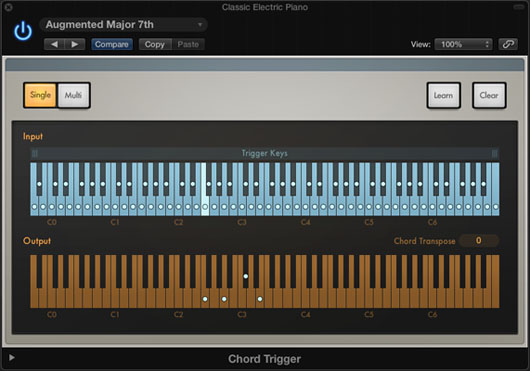
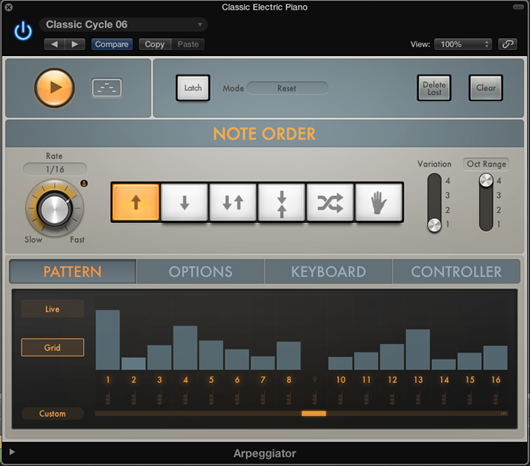
How It Sounds
Like any audio production program, Logic only sounds as good as the person using it. With that in mind, Logic X does give users everything they need to make dense, unique, and professional-sounding productions. Its stock EQs and compressors are not the most hi-fi options, but are more than enough to get the job done well. And the long list of software instruments and FX which come with the program are not simply there to look cool, they actually can sound nice, and—especially with a bit of extra work—can result in rather unique tones. In particular, the electric piano, acoustic piano, and organ-modelling virtual instruments can be extremely useful for producers who would like to include such sounds in their productions, but don’t have the means to record in a studio. Maybe the plug-ins won’t sound exactly like a B3 or a Steinway, but they will certainly work fine in a simple house track. Furthermore, Logic X’s new instruments and FX—like the Retrosynth, Bass Amp Designer, and newly added FX boxes found on the program’s virtual pedal board—add fresh and interesting sonic flavors to the program.
A Retrosynth preset
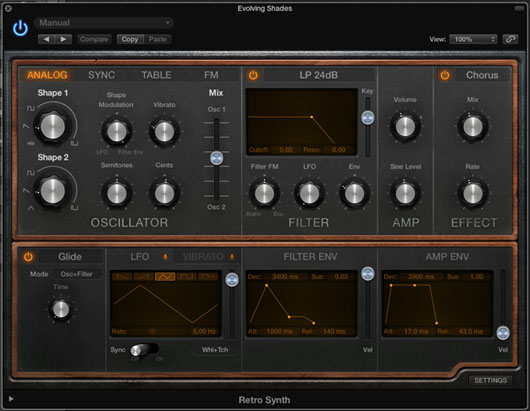
The Bottom Line
Logic X costs about $200, putting it well below Live 9, Reason 7, and Cubase 7—all programs that essentially aim to accomplish the same tasks. Still, it seems likely that Apple may have kept the price this reasonable to help offset the program’s other costs; users are required to update their Mac to the newest OS, their existing 32-bit plug-ins will no longer work in this updated version, and an iPad is practically necessary to unlock the full potential of Logic X.
In the end, an update from Logic 9 to Logic X seems essential for existing users. Without a doubt, Logic X is an overdue improvement to the program, one that works smarter than the previous version and addresses many issues Logic probably should have dealt with long before now. Logic X may also be an attractive starting point for people who are beginning their ventures into digital music production. While maybe not the most intuitive program, it’s not too difficult to start working on decent-sounding music in a reasonable amount of time, and for those who stick with it and dig into the program, there is a lot of room to grow. That said, there’s nothing totally earth-shattering about Logic X. The “big” new features included with the program—mainly the Drummer instrument (a plug-in which creates a surprisingly natural sounding, human-played drum performance from inside the computer)—may be incredible from a computer-technology-advancement standpoint, but cater to users who aim to make Logic sound more like a traditional “band”—which is to say it likely won’t be utilized by electronic musicians and producers. For those who have spent many days, weeks, months, and years learning comparable production programs, a jump to Logic X does not seem to be an urgent necessity. On the other hand, there is no denying that the program boasts a powerful set of features and sounds unique to its platform.
MSRP: $199.99

